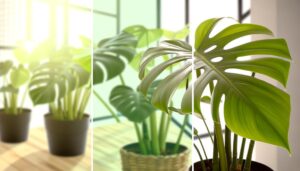How to Identify Monstera Deliciosa
To identify Monstera deliciosa, observe its large, shiny, heart-shaped leaves measuring up to 90 cm in length and 75 cm in width. Leaves exhibit distinctive fenestrations and perforations, becoming more pronounced with maturity.
Petioles can reach up to 1 meter, supporting the expansive leaf blades. The plant's aerial roots, smooth medium to dark green petioles, and a sheathing ocrea are also indicative.
Inflorescences feature a creamy white spadix and boat-shaped spathe, with bisexual flowers. When mature, the sorosis fruit resembles an elongated pinecone, green transforming to yellowish-green.
Discover further nuanced details and specific care requirements ahead.
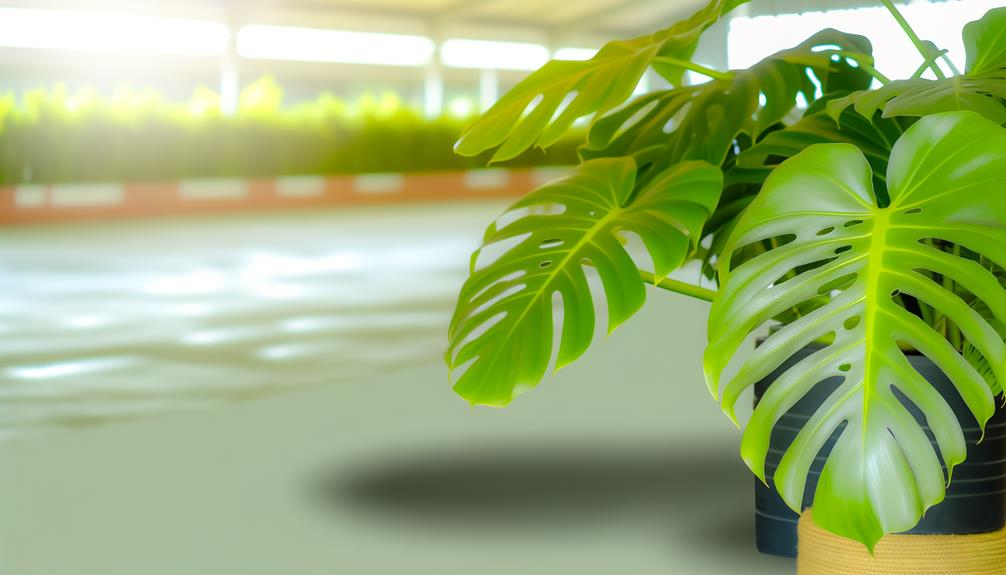
Key Takeaways
- Look for large, heart-shaped leaves with glossy, dark green coloration and a leathery texture.
- Identify unique fenestrations and perforations that become more pronounced as the plant matures.
- Observe the petioles, which can extend up to 1 meter and support the leaf's surface area.
- Check for inflorescence with a creamy white spadix and boat-shaped spathe, indicating reproductive morphology.
- Note the vibrant green coloration of mature leaves and the lighter green of young leaves, often with a shiny finish.
Leaf Shape and Size
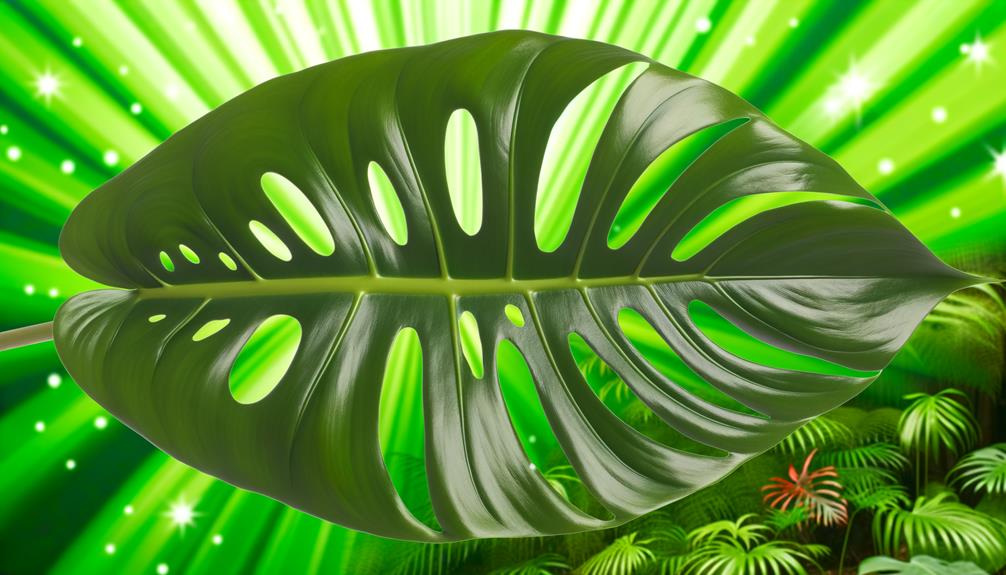
Monstera deliciosa, commonly known as the Swiss cheese plant, displays distinctive foliage characterized by large, heart-shaped leaves that can reach up to 90 centimeters in length and 75 centimeters in width, often featuring unique fenestrations and perforations.
These leaves are glossy, dark green, and have a leathery texture, contributing to their robust appearance. The petioles, or leaf stems, can extend up to 1 meter, providing substantial support for the expansive leaf blades.
The plant's overall morphology allows it to thrive in its native tropical habitats, where it can climb and spread efficiently. Such significant leaf dimensions are essential for maximizing photosynthetic efficiency, hence enabling the Monstera deliciosa to grow vigorously in both natural and cultivated environments.
Characteristic Leaf Holes
The characteristic fenestrations of Monstera deliciosa, which can range from small perforations to large, elongated holes, are influenced by natural growth patterns, genetic factors, and environmental conditions.
Leaf morphology varies considerably, with fenestration patterns becoming more pronounced as the plant matures and under ideal light and humidity levels.
These structural adaptations facilitate efficient light capture and mitigate wind damage, enhancing overall plant resilience.
Natural Growth Patterns
Characterized by fenestrations that emerge as the plant matures, the leaves of Monstera deliciosa exhibit distinct perforations which are hypothesized to aid in optimizing light capture and reducing wind damage in their native tropical habitats.
These fenestrations, or natural holes, initially appear when the leaf reaches approximately 25-30 cm in diameter. As Monstera deliciosa ages, the fenestrations progressively enlarge and multiply, often occupying up to 70-80% of the leaf surface area.
This adaptive morphology is believed to facilitate photosynthesis by allowing light to penetrate through multiple leaf layers in dense forest canopies. Additionally, the perforations may reduce mechanical stress from high-velocity winds, thereby enhancing the structural integrity of the foliar architecture in these climatically dynamic environments.
Leaf Shape Variations
Leaf morphology in Monstera deliciosa exhibits significant variations, particularly in the development of fenestrations, which can range from simple slits to complex patterns of multiple, irregular perforations. These fenestrations, also known as leaf holes, typically emerge as the plant matures, starting as small slits near the leaf margins and eventually expanding into larger, more intricate formations.
Juvenile leaves tend to be smaller and lack these characteristic perforations, while mature leaves, often exceeding 60 cm in length and 45 cm in width, display prominent fenestrations. The presence and extent of these fenestrations are indicative of the plant's developmental stage and can serve as a key diagnostic feature in the identification of Monstera deliciosa.
Environmental Influences
Environmental factors like light intensity, humidity levels, and nutrient availability greatly influence the development and morphology of fenestrations in Monstera deliciosa leaves.
Best light conditions, typically ranging from 100 to 500 μmol m⁻² s⁻¹, encourage the formation of characteristic perforations.
Relative humidity levels above 60% are conducive to fenestration expansion, as lower humidity can lead to incomplete leaf development.
Nutrient-rich substrates, particularly those high in nitrogen (N) and potassium (K), are essential for robust leaf growth and fenestration.
Conversely, deficiencies in these essential nutrients can result in reduced or absent fenestrations.
Understanding these environmental parameters is vital for horticulturists aiming to cultivate Monstera deliciosa with the distinctive, aesthetically pleasing leaf patterns.
Growth Pattern
Monstera deliciosa exhibits an indeterminate growth pattern, where its aerial roots and climbing habit allow it to ascend structures and spread horizontally, often achieving heights of up to 20 meters in its natural habitat.
This perennial vine demonstrates significant plasticity in growth, adapting to both terrestrial and epiphytic lifestyles. The plant's stems elongate continuously, producing large, fenestrated leaves that can reach lengths of 60–90 cm.
Internodal distances vary, influenced by light availability and support structures. The growth rate is contingent upon environmental factors, including humidity, temperature, and light intensity, typically flourishing in conditions replicating its native tropical rainforests.
Regular pruning can manage its expansive nature, making it suitable for indoor cultivation while maintaining its distinctive morphology.
Aerial Roots
A notable characteristic of Monstera deliciosa's climbing habit is the development of strong aerial roots, which emerge from the stem nodes and serve to anchor the plant to various surfaces, facilitating its vertical and horizontal expansion. These adventitious roots exhibit several distinctive features:
- Morphology: Typically cylindrical, measuring 2-3 cm in diameter.
- Functionality: Provide structural support and absorb moisture and nutrients from the environment.
- Growth Rate: Extend at an approximate rate of 10-15 cm per month under best conditions.
- Environmental Adaptability: Capable of attaching to diverse substrates including tree bark, rocks, and artificial supports.
Understanding these aerial roots is essential for proper Monstera deliciosa identification and care, contributing significantly to its epiphytic lifestyle and overall vigor.
Stem Structure
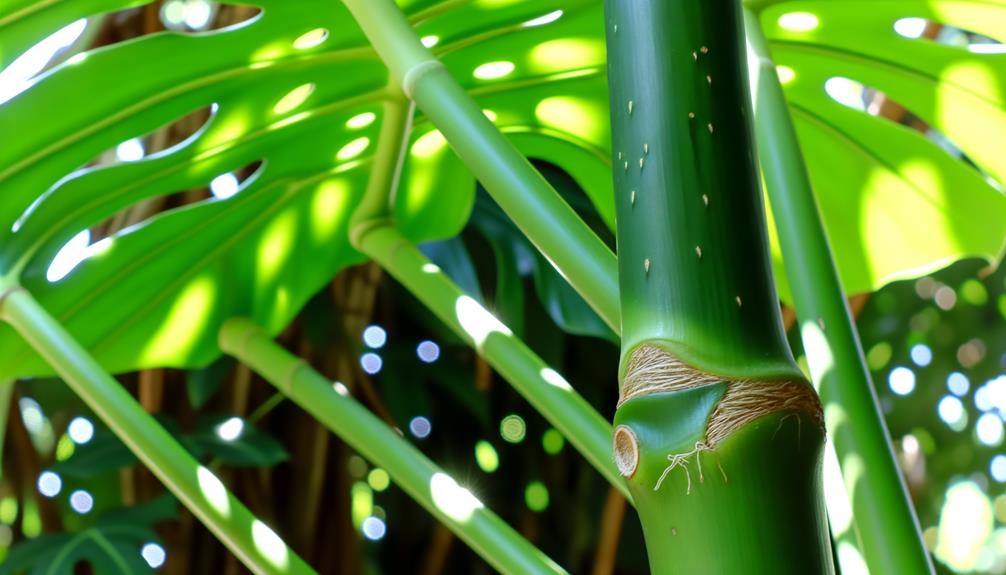
The stem structure of Monstera deliciosa exhibits a strong and flexible morphology, characterized by its cylindrical shape and the presence of distinct nodes from which leaves and aerial roots emerge. The internodes typically measure between 2 to 4 centimeters, providing structural integrity and facilitating nutrient transport. The epidermis is smooth and green, sometimes showing a slightly glossy surface. The stem's ability to produce adventitious roots supports its climbing nature, allowing it to adhere to surfaces.
| Feature | Description |
|---|---|
| Shape | Cylindrical |
| Diameter | 2-4 centimeters |
| Surface Texture | Smooth, slightly glossy |
| Node Presence | Distinct nodes from which leaves and aerial roots emerge |
| Climbing Ability | Enhanced by adventitious roots which facilitate attachment to various surfaces |
This complex stem architecture underpins the plant's vertical growth and overall health.
Leaf Texture
The leaf texture of Monstera deliciosa is characterized by a smooth surface with a distinctive fenestration pattern, consisting of oblong holes and perforations.
The adaxial surface exhibits a glossy green appearance, indicative of healthy chlorophyll levels and ideal light absorption.
Leaf measurements typically range from 25 to 90 centimeters in length, depending on the plant's maturity and environmental conditions.
Smooth Leaf Surface
Monstera deliciosa leaves display a sleek, shiny texture that is indicative of their healthy condition and proper hydration levels. The outer layer of these leaves is marked by a consistent, waxy cuticle layer, which reduces transpiration and efficiently bounces off light.
This sleek texture can be evaluated by gently gliding your fingers across the lamina, observing the lack of roughness or ridges.
Key characteristics of the smooth leaf surface include:
- Shiny Finish: A lustrous sheen that reflects light.
- Consistent Texture: Uniformity throughout the entire leaf surface.
- Protective Waxy Coating: A layer that helps in retaining moisture.
- Hydration Signs: A smooth surface indicates ideal water availability.
Understanding these features assists in the accurate recognition and maintenance of Monstera deliciosa.
Distinctive Leaf Holes
Characterized by fenestrations, Monstera deliciosa leaves exhibit distinctive perforations that develop as the plant matures and contribute to its unique appearance.
These fenestrations, or natural holes, begin to form when the plant reaches approximately 1 to 3 years of age.
Typically, the leaf blades, which can measure up to 90 cm in length and 60 cm in width, display a variable number of these perforations.
The fenestrations may vary in size and shape, ranging from small, round holes to elongated slits, enhancing the leaf's overall texture.
Such morphological adaptations are hypothesized to facilitate light penetration to lower foliage and reduce wind resistance.
This distinctive leaf feature is a key identification marker for Monstera deliciosa, setting it apart from other Araceae family members.
Glossy Green Appearance
Exhibiting a shiny green sheen, the leaves of Monstera deliciosa possess a tough texture that contributes to their robust and enduring nature. This characteristic sheen is not merely aesthetic but also indicative of the plant's overall health and importance. The leaves can reach dimensions up to 90 cm (35 inches) in length and 75 cm (30 inches) in width, showcasing their substantial size.
Key features of the Monstera deliciosa leaf texture include:
- Tough Surface: Provides durability and resistance to physical damage.
- Shiny Finish: Reflects light, indicating a healthy epidermis.
- Thick Cuticle: Reduces water loss and enhances longevity.
- Prominent Veins: Facilitate efficient nutrient and water transport.
Such attributes make the Monstera deliciosa a resilient and visually striking species.
Color of Leaves
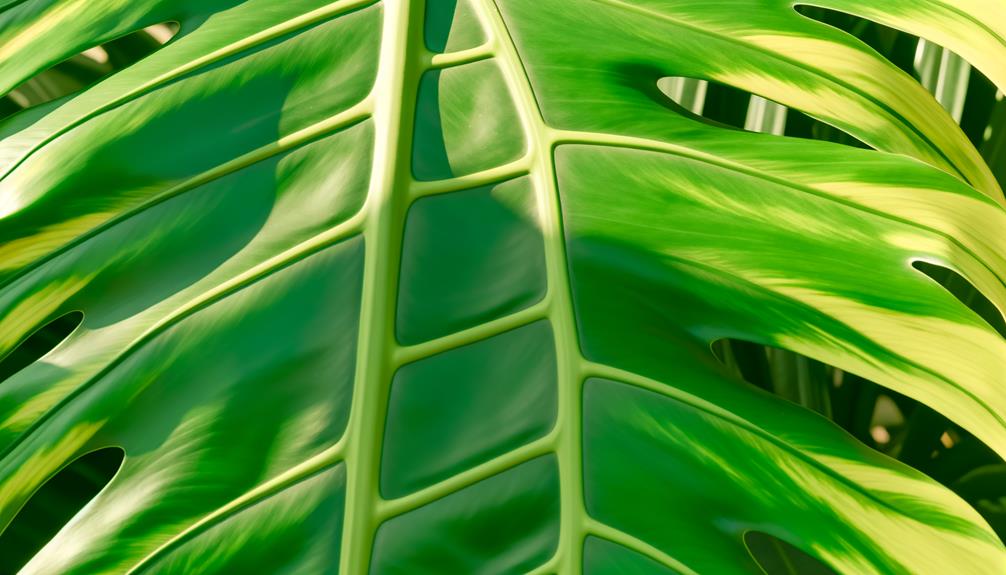
The leaves of Monstera deliciosa exhibit a vibrant green coloration, often characterized by a glossy surface due to the presence of cuticular wax. This lush hue, ranging between Pantone 364C and 371C, is indicative of healthy chlorophyll concentration within the leaf tissue.
Young leaves typically present a lighter green (Pantone 367C) before maturing into a darker shade. The adaxial (upper) surface tends to be more lustrous compared to the abaxial (lower) surface, which may appear slightly paler. This color variation is crucial for optimizing photosynthetic efficiency.
Additionally, variegated cultivars may display patches of cream or white, a result of genetic mutations affecting chloroplast distribution. Understanding these color dynamics is important for accurate identification and assessment of plant health.
Petiole Features
In Monstera deliciosa, the petioles are robust and elongated, measuring between 30 to 60 centimeters in length, and play a critical role in supporting the expansive leaf blades. These petioles exhibit several distinctive characteristics that aid in the identification of the species:
- Coloration: Typically a medium to dark green hue, sometimes exhibiting a slight gloss.
- Texture: Smooth surface with occasional minute ridges or striations.
- Attachment: The petioles connect at the leaf base, forming a sheathing structure known as an ocrea.
- Shape: Slightly flattened in cross-section, contributing to structural integrity and flexibility.
These features collectively enable the petioles to effectively sustain the weight and surface area of Monstera deliciosa's large, fenestrated leaves.
Fruiting and Flowers
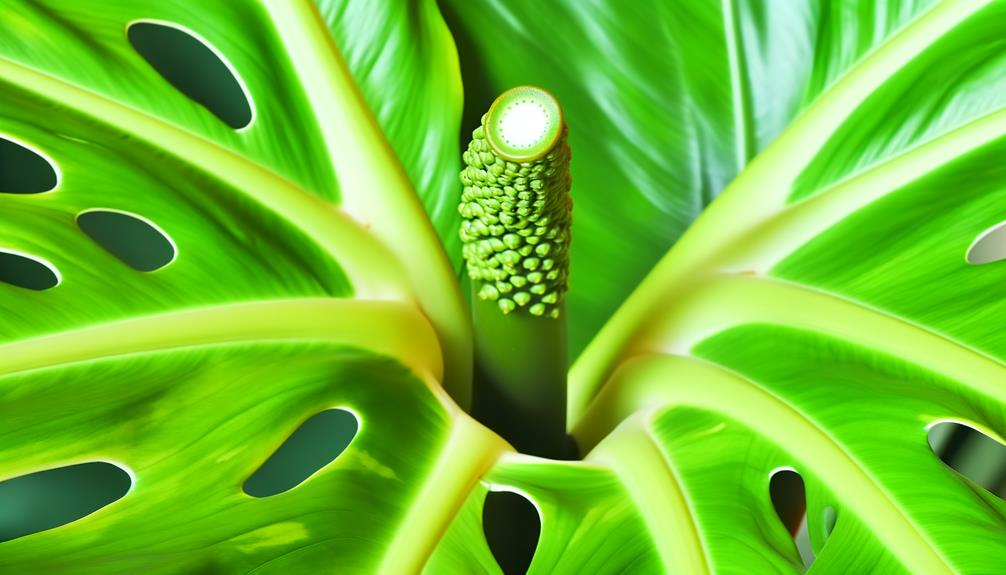
Beyond the structural attributes of the petioles, Monstera deliciosa also presents distinct characteristics in its fruiting and flowering phases, which are critical for accurate species identification.
The inflorescence consists of a creamy white spadix, approximately 12–15 cm in length, surrounded by a boat-shaped spathe. The spadix bears numerous small bisexual flowers.
The fruit, known as a sorosis, resembles an elongated pinecone, measuring 25–30 cm in length and 3–4 cm in diameter. It shifts from green to a yellowish-green hue as it matures. The fruit is covered with hexagonal scales that detach upon ripening, revealing a creamy, aromatic pulp.
These botanical features not only aid in identification but also underscore the unique reproductive morphology of Monstera deliciosa.
Common Lookalikes
When distinguishing Monstera deliciosa from its common lookalikes, it is essential to examine specific morphological traits such as leaf fenestration patterns, petiole structure, and overall plant habitus.
Monstera adansonii, Philodendron bipinnatifidum, and Rhaphidophora tetrasperma are frequently mistaken for Monstera deliciosa. Key characteristics to differentiate Monstera deliciosa include:
- Leaf Size: Mature leaves can reach up to 90 cm in length, notably larger than Monstera adansonii.
- Fenestration: Monstera deliciosa exhibits multiple, irregularly shaped perforations, unlike the consistent, smaller holes in Monstera adansonii.
- Petiole Geniculum: Presence of geniculum (joint-like structure) at the base of the petiole.
- Growth Habit: Monstera deliciosa displays a robust, climbing growth habit, whereas Rhaphidophora tetrasperma remains more compact.
Understanding these traits facilitates accurate identification.
Care Requirements
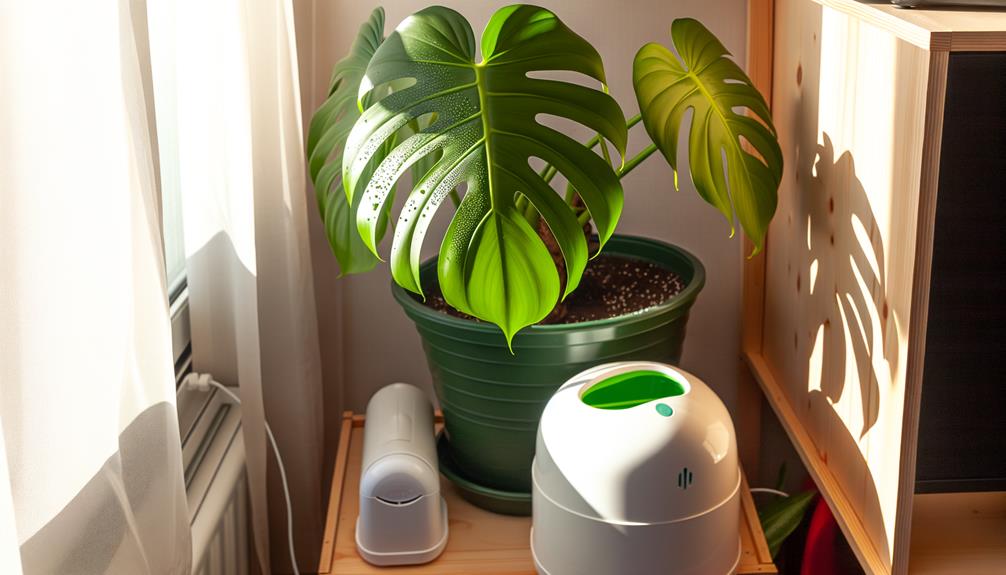
Finest care for Monstera deliciosa involves maintaining a balance of indirect light exposure, consistent soil moisture, and ambient humidity levels of 60-80%. Peak growth is achieved in bright, indirect sunlight, avoiding direct exposure which can cause foliar burn.
Soil should remain evenly moist but not waterlogged, utilizing a well-draining potting mix with a pH of 5.5-7.0. Watering should be adjusted based on climatic conditions, ensuring the substrate is kept damp but not saturated.
Ambient humidity is critical; maintaining levels between 60-80% can prevent leaf browning and promote healthy fenestration. Fertilize bi-monthly during the growing season with a balanced, water-soluble fertilizer (20-20-20) to support vigorous growth.
Regular pruning and support structures may be required due to the plant's vining nature.
Conclusion
To sum up, Monstera deliciosa can be recognized by its unmatched leaf morphology, such as its unique fenestrations and considerable size. The species showcases a distinctive growth pattern, marked by strong aerial roots and a resilient stem framework.
Petiole characteristics, in addition to the existence of particular fruiting bodies and flowers, further differentiate this plant from typical doppelgangers. Proficiency in identifying Monstera deliciosa entails comprehending its exact anatomical and physiological traits, making it an undeniable wonder among botanical specimens.





